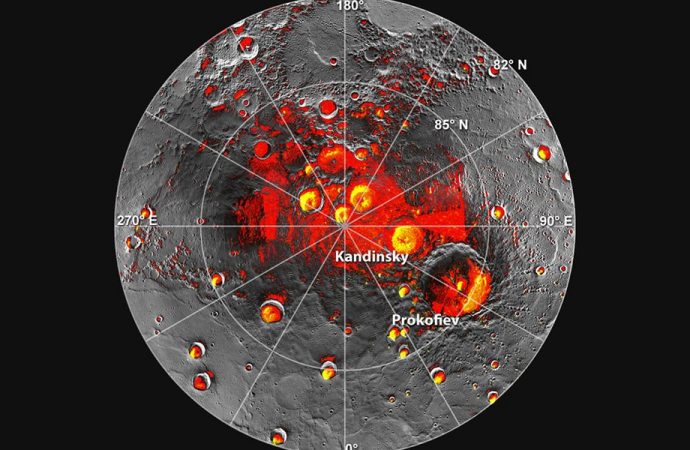New analysis of observations made by NASA’s MESSENGER mission reveal where the solar system’s innermost planet’s water ice is but not where it’s from.
Although Mercury is the closest planet to the sun, some of its craters hide water ice in their shaded depths — but how much ice is there, and where exactly did it come from?
A new study has part of the answer, suggesting that the ice is around 50 meters thick on average, but there is considerable uncertainty with that measurement. What kind of comets deposited the water there in the first place, however, is a mystery.
The researchers based their information on the Mercury Laser Altimeter instrument on the now-complete NASA MESSENGER mission, which crashed into Mercury as planned in 2015. Previously, a combination of Earth-based radar and neutron data suggested water ice deposits that were at least one to two meters thick. The new data suggests an ice thickness of 50 meters, possibly up to 85 meters.
But what’s possibly most intriguing is figuring out the source of this ice. The researchers aren’t quite sure if the ice came from long-period Halley-type comets (which originate from the Oort Cloud, a collection of icy objects far out in the solar system) or short-period Jupiter-family comets (which originate from the Kuiper Belt, an icy group of objects beyond Neptune’s orbit).
“If we had found a lower limit for the ice depth that was significantly greater than zero, which we didn’t quite, then we would have been able to rule out the possibility of Halley-type comets or asteroids being responsible for delivering Mercury’s water,” said Vincent Eke, a reader in the department of physics at Durham University, U.K., in an email to Seeker. Eke is the lead author of a paper published in the journal Icarus.
“The models for the micrometeorite flux reaching Mercury are quite uncertain,” Eke Some of the more modern models could manage to bring 50 meters of ice to the polar craters, as could Jupiter-family comets. Also, if the ice depth is as thick as 50 meters in all the polar craters, then it would rule out the possibility that the ice was all brought by a single recent impact. One other study did consider that the impactor that created Hokusai crater might have been responsible for the polar water ice deposits.”
Artist’s impression of the BepiColombo mission at Mercury (Astrium).
When asked what was the significance of the results, Eke added they were “still a little bit too tantalizing” because the ice depth was not defined as precisely as he would like. Eke said he plans to use the final MESSENGER MLA data to provide better sampling of the polar regions, allowing him to see more craters — perhaps including smaller ones — to give a tighter constraint on the ice depth.
Failing that, there’s another Mercury mission called BepiColombo that is headed to Mercury in the 2020s. The European mission should be carrying a laser altimeter, and Eke said he is hopeful the methods in his team’s paper could improve the constraint on the ice thickness.
“If BepiColombo flies low over the south pole, rather than the north pole like MESSENGER, then this would also be helpful to increase the number of well-measured polar craters. I’m not sure that the orbit has yet been decided,” he said.
“The limiting factor is not how accurately an individual altitude is measured, because both the MLA and [BepiColombo laser altimeter] do this to better than 1 meter. However, craters have departures from axisymmetry of up to 100 meters due to subcratering impacts. We need to average over enough craters to ensure that the height difference we’re measuring is caused by ice, rather than just being intrinsically rough craters.”
Source: Seeker


































Leave a Comment
You must be logged in to post a comment.